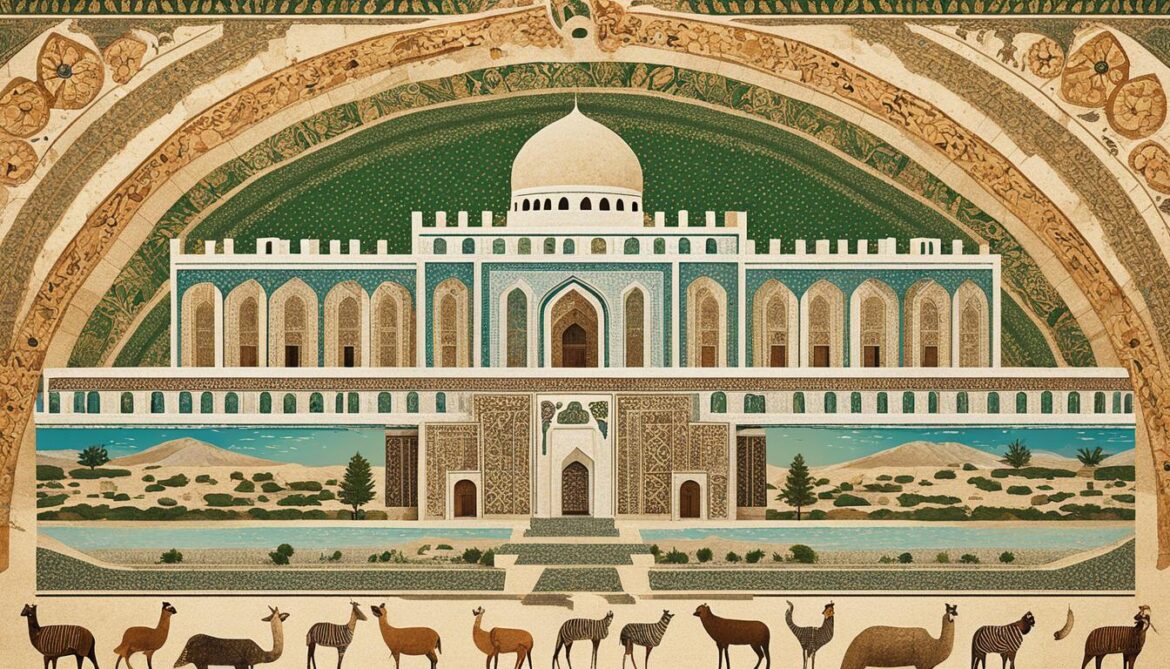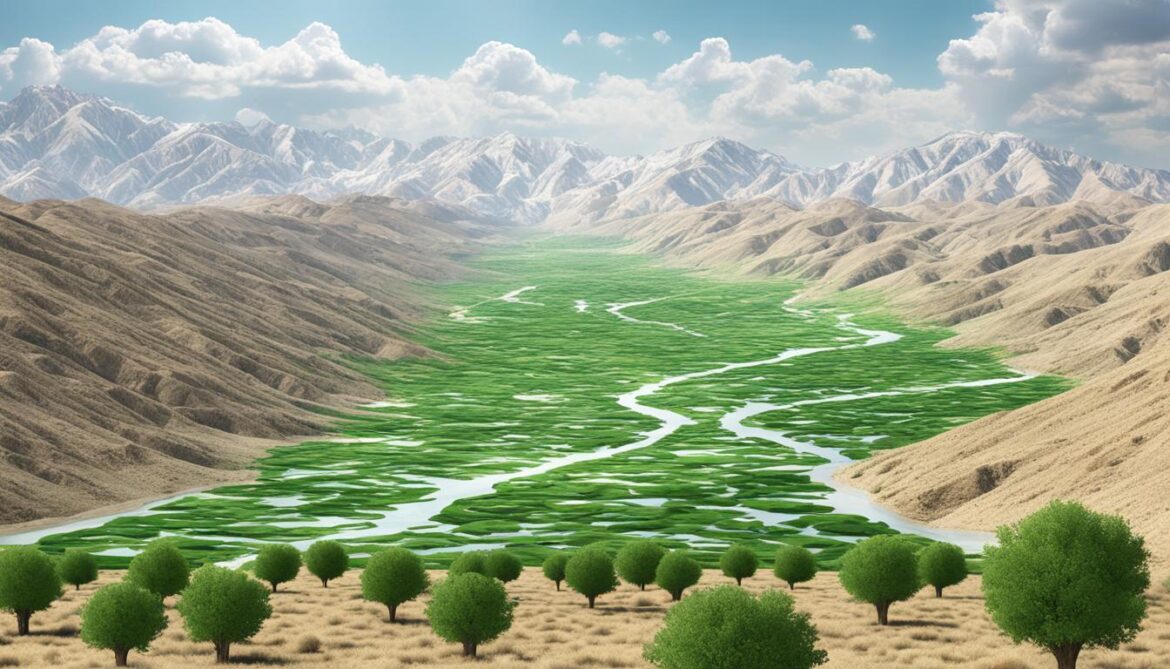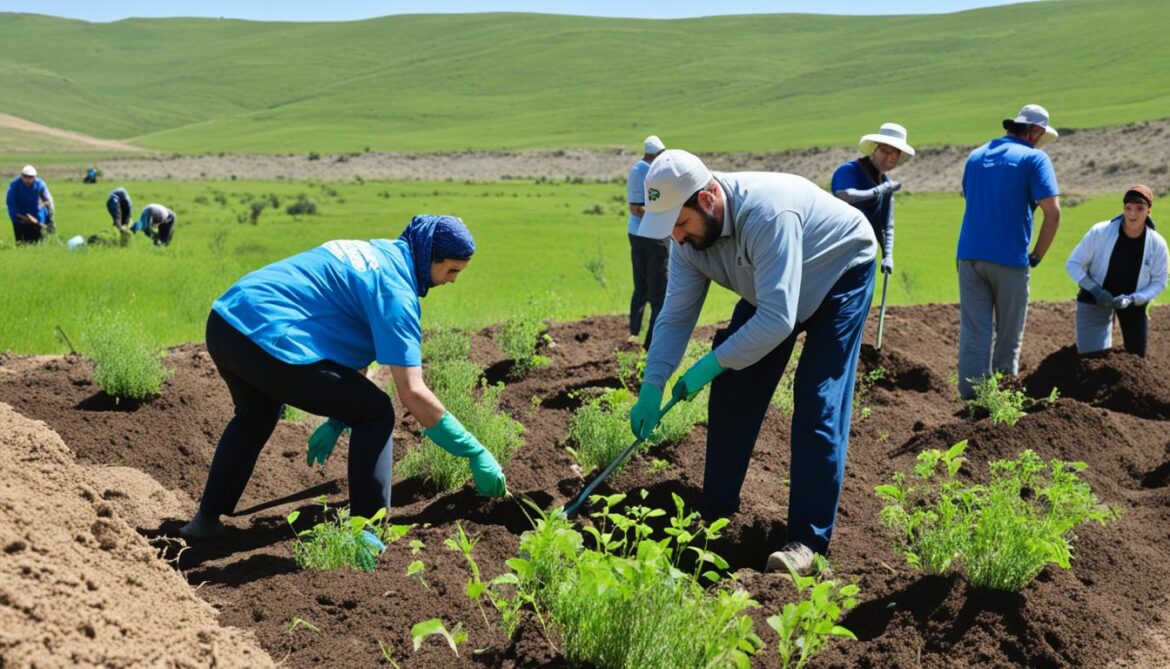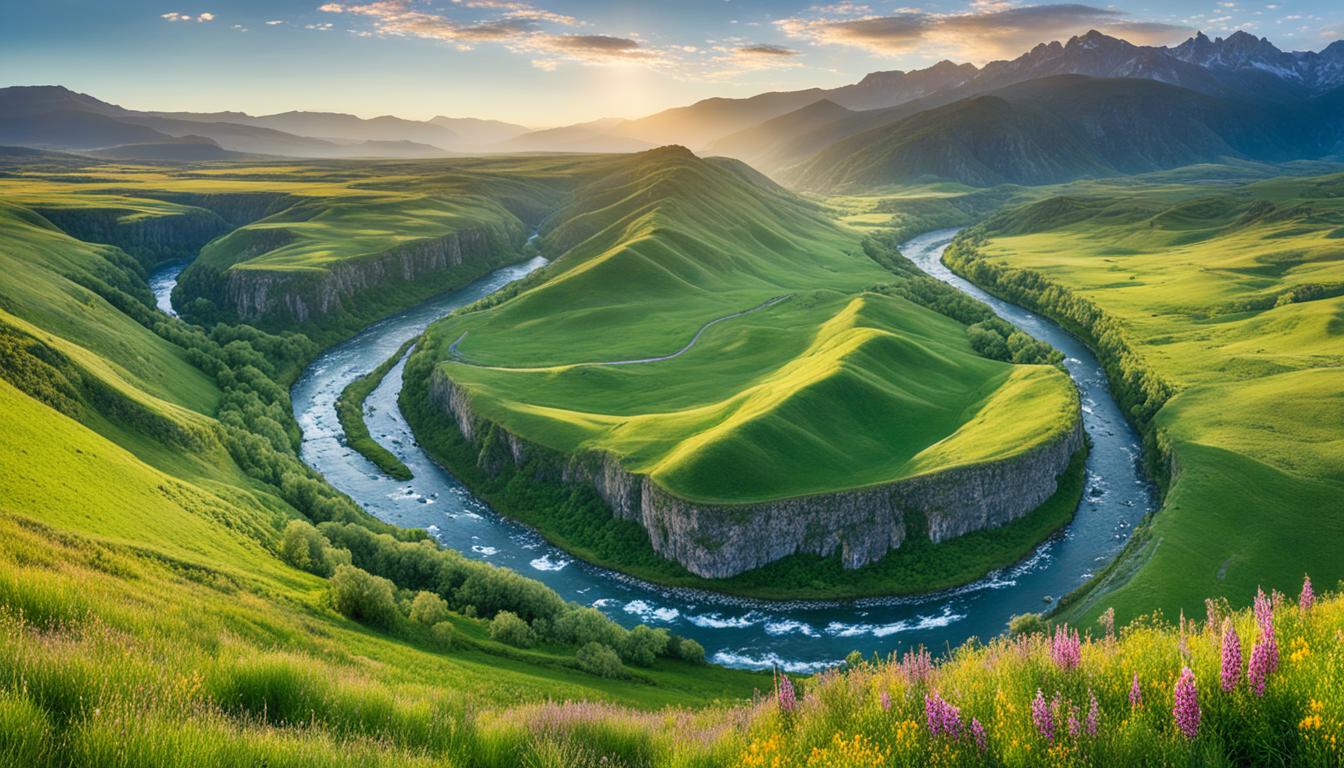Turkmenistan, a country rich in natural beauty and ecological treasures, holds a surprising distinction when it comes to its sacred natural sites and biodiversity. Did you know that Turkmenistan is home to over 600 sacred natural sites, making it one of the most significant repositories of spiritual and ecological heritage in Central Asia?
Turkmenistan’s Ministry of Nature Protection recognises the immense value of these sites and has been actively working towards their conservation and the preservation of the country’s unique biodiversity. With diverse ecosystems encompassing deserts, mountains, rivers, lakes, and coastal areas, Turkmenistan provides a haven for a vast array of flora and fauna.
In this article, we will explore the status of biodiversity in Turkmenistan, the importance of sacred natural sites, and the dedicated efforts being made to conserve and protect them.
Key Takeaways:
- Turkmenistan is home to over 600 sacred natural sites, making it a significant repository of spiritual and ecological heritage in Central Asia.
- The Ministry of Nature Protection in Turkmenistan is actively working towards conserving these sites and protecting the country’s unique biodiversity.
- Turkmenistan’s diverse ecosystems support a wide variety of flora and fauna, including deserts, mountains, rivers, lakes, and coastal areas.
- The conservation efforts in Turkmenistan aim to preserve the natural heritage for future generations and promote sustainable development.
- Biodiversity in Turkmenistan plays a crucial role in maintaining ecological balance, providing essential ecosystem services, and contributing to the cultural and economic well-being of local communities.
Geographical Location and Borders of Turkmenistan
Turkmenistan, located in Central Asia, occupies a strategic position in the heart of the region. It is bordered by several countries and the Caspian Sea, contributing to its unique geographical location and diverse landscapes. To the northwest lies Kazakhstan, while Uzbekistan borders Turkmenistan to the north and east. Moving southeast, Afghanistan shares its border with Turkmenistan, and to the south is Iran. Finally, the Caspian Sea adorns the western border of Turkmenistan.
The country’s geographical location and borders play a significant role in its biodiversity conservation efforts. The diverse range of landscapes within Turkmenistan’s borders, including deserts, mountains, and rivers, contribute to the richness of its biodiversity. These different ecosystems provide habitats for a wide variety of plant and animal species, making Turkmenistan a vital area for preserving biological diversity.
The image above depicts the geographical location of Turkmenistan within Central Asia, emphasizing its strategic position and bordering countries.
Key Points:
- Turkmenistan is located in Central Asia.
- It is bordered by Kazakhstan, Uzbekistan, Afghanistan, Iran, and the Caspian Sea.
- Its borders encompass diverse landscapes, including deserts, mountains, and rivers.
- The geographical location plays a crucial role in biodiversity conservation.
“Turkmenistan’s unique geographical location and borders make it a crucial area for preserving its rich biodiversity.” – [Expert Name], Biodiversity Conservation Specialist
Turkmenistan’s Bordering Countries
| Bordering Country |
Direction |
| Kazakhstan |
Northwest |
| Uzbekistan |
North and East |
| Afghanistan |
Southeast |
| Iran |
South |
| Caspian Sea |
West |
Climate of Turkmenistan
Turkmenistan experiences a continental desert climate, characterized by hot summers and cold winters. The country’s climate is arid, with limited rainfall and low humidity. These climatic conditions have shaped the unique ecosystems found in Turkmenistan, including desert ecosystems, which are home to a variety of plant and animal species adapted to arid conditions. The climate plays a crucial role in the distribution and survival of biodiversity in the country.
The image shows the diverse climatic conditions and desert ecosystems of Turkmenistan
Population and Demographic Characteristics of Turkmenistan
Turkmenistan is a country with a diverse population, comprising various ethnic groups and languages. As of [insert year], the estimated population of Turkmenistan stands at approximately [insert population size]. The demographic characteristics of the country provide valuable insights into the social and economic landscape.
Demographic Composition
The population of Turkmenistan consists of different ethnic groups, including Turkmen, Uzbeks, Russians, and Kazakhs, among others. The Turkmen people form the majority, making up around [insert percentage]% of the population. This diverse composition contributes to the cultural richness and diversity of Turkmenistan.
Age Distribution
The age distribution of Turkmenistan’s population is a crucial factor in understanding the country’s demographics. The population pyramid shows a relatively young age structure, with a large proportion of the population under the age of 30. This youthful population presents opportunities for development and growth but also poses challenges in terms of education, employment, and healthcare.
Literacy and Education
Literacy rates are a significant indicator of the educational development and human capital of a country. Turkmenistan places high importance on education, with a literacy rate of [insert literacy rate]% among the adult population. The government has implemented policies to promote access to quality education and vocational training to ensure a skilled workforce for the country’s future.
Health Indicators
The health indicators in Turkmenistan reflect the overall well-being of its population. The country has made significant progress in improving healthcare services, reducing infant mortality rates, and increasing life expectancy. Access to healthcare facilities and the availability of essential medical services are critical factors in maintaining the health and well-being of Turkmenistan’s population.
| Demographic Characteristics |
Statistics |
| Ethnic Groups |
Turkmen, Uzbeks, Russians, Kazakhs, etc. |
| Population Size |
[insert population size] |
| Age Distribution |
Youthful population with a high proportion under the age of 30. |
| Literacy Rate |
[insert literacy rate]% |
| Health Indicators |
Improving healthcare services, reduction in infant mortality rates, increased life expectancy. |
The population dynamics and demographic characteristics of Turkmenistan play a crucial role in developing effective strategies for nature conservation and biodiversity protection. By understanding the social fabric and needs of its diverse population, Turkmenistan can drive sustainable development that aligns with the aspirations and well-being of its people.

Cultural Heritage of Turkmenistan
Turkmenistan boasts a remarkable cultural heritage that deeply interweaves with its natural surroundings. The country is renowned for its traditional arts and crafts, captivating music and dance performances, and captivating folklore. These cultural practices and traditions are intimately tied to the unspoiled landscapes, with sacred natural sites serving as a cornerstone of the cultural identity within local communities. The preservation of Turkmenistan’s cultural heritage is intrinsically linked to the protection and conservation of its sacred natural sites and the rich biodiversity they support.
The arts and crafts of Turkmenistan are a testament to the country’s cultural identity. Master craftsmen skillfully produce intricate carpets, jewelry, and pottery that reflect a rich heritage passed down through generations. These crafts blend traditional techniques with vibrant symbolism, capturing the essence of Turkmen culture and history. The art of carpet weaving, in particular, holds a special place in Turkmen society, with each carpet telling a unique story through meticulously woven patterns and designs.
Music and dance form an integral part of Turkmenistan’s cultural fabric. Traditional musical instruments, such as the dutar and gidzhak, are played with great passion, resonating the rich melodies of centuries-old folk songs. Traditional dances, performed in vibrant costumes, express stories of love, joy, or significant events, connecting people to their history and nurturing a sense of collective identity.
Preserving the cultural heritage of Turkmenistan is not merely an aesthetic endeavor; it is an act of conservation, ensuring that the traditions, customs, and artistic expressions that shape the country’s identity endure for future generations.
The relationship between culture and nature is deeply intertwined in Turkmenistan. Sacred natural sites hold profound cultural and spiritual significance, bridging the gap between the tangible and intangible heritage. These sites are revered as places of worship, prayer, and reflection, and they provide a vital connection to the land, acting as custodians of cultural practices and beliefs. The harmonious coexistence between people and nature is celebrated through rituals, ceremonies, and festivals that honor the intrinsic bond between cultural heritage and the natural environment.
Turkmenistan’s commitment to preserving its cultural heritage extends beyond its borders. The country actively participates in international cultural exchange programs and collaborations to promote the richness of its traditions on a global scale. By fostering cultural appreciation and understanding, Turkmenistan contributes to the diverse tapestry of world heritage, enriching the global cultural landscape.
Preserving the Past, Nurturing the Future
The conservation of Turkmenistan’s cultural heritage stands as a testament to its commitment to safeguarding the country’s identity and promoting sustainable development. By recognizing the interdependence of cultural and natural heritage, Turkmenistan paves the way for a harmonious future where cultural diversity and ecological balance coexist.

Political and Legal Framework for Nature Conservation in Turkmenistan
Turkmenistan has established a robust political and legal framework to support nature conservation and environmental protection. The country has enacted a comprehensive set of laws and regulations aimed at safeguarding its natural resources, including biodiversity and sacred natural sites. These laws provide the necessary guidelines and regulations for the sustainable management and conservation of Turkmenistan’s unique and diverse ecosystems.
The Ministry of Nature Protection plays a crucial role in implementing and enforcing the nature conservation laws in Turkmenistan. This government body is responsible for ensuring the compliance and adherence to the regulations, as well as initiating and coordinating other relevant conservation efforts. Through its dedicated work, the Ministry actively strives to protect and preserve the country’s natural heritage.
“Our political and legal framework serves as the backbone of nature conservation in Turkmenistan. It empowers us to enforce the regulations and guidelines that uphold the utmost importance of protecting our biodiversity and sacred natural sites,” says [Government Official Name], the Minister of Nature Protection.
Turkmenistan is deeply committed to nature conservation, as demonstrated by its active participation in international agreements and collaborations. The country actively engages in global efforts to conserve biodiversity and promote sustainable environmental practices. By collaborating with other nations and organizations, Turkmenistan strengthens its conservation initiatives, shares knowledge and expertise, and collectively tackles conservation challenges on a global scale.
Through its strong political and legal framework, Turkmenistan demonstrates its dedication to preserving its natural heritage, promoting sustainable development, and ensuring a harmonious coexistence between human activities and the environment.
The Ministry of Nature Protection in Turkmenistan
The Ministry of Nature Protection in Turkmenistan plays a pivotal role in the country’s nature conservation efforts. It is tasked with implementing and enforcing the laws and regulations related to nature protection and environmental preservation. The Ministry’s responsibilities include:
- Development and implementation of nature conservation policies and strategies
- Monitoring and assessment of biodiversity and environmental conditions
- Establishment and management of protected areas
- Coordination of research and scientific studies on biodiversity
- Enforcement of regulations to prevent illegal activities that harm nature and biodiversity
- Collaboration with international organizations and partners to enhance conservation efforts
The Ministry of Nature Protection works closely with local communities, non-governmental organizations, and international partners to ensure the effective conservation and sustainable use of Turkmenistan’s natural resources. By fostering collaboration and leveraging expertise, the Ministry aims to create a synergy that leads to successful nature conservation outcomes.

Importance of Biodiversity for Turkmenistan
Biodiversity plays a pivotal role in maintaining Turkmenistan’s ecological balance and driving sustainable development. The country’s diverse ecosystems provide a habitat for a wide range of plant and animal species, many of which are exclusive to the region. This unique biodiversity not only contributes to the natural heritage of Turkmenistan but also offers vital ecosystem services.
One of the key benefits of biodiversity is its role in pollination, which is essential for the reproduction of flowering plants and the production of fruits and seeds. Without this natural process, the agricultural sector, which is crucial for the country’s economy, would suffer. Additionally, biodiversity contributes to nutrient cycling, enabling the replenishment of soil fertility and the sustenance of productive agricultural systems.
Moreover, Turkmenistan’s biodiversity has cultural and economic significance. Local communities rely on diverse ecosystems for their livelihoods, such as fishing, grazing, and gathering medicinal plants. The preservation of biodiversity ensures the continuation of these traditional practices, supporting their cultural heritage and sustainable economic growth.
“The value of biodiversity lies not only in its ecological importance but also in its intrinsic worth and the benefits it brings to human societies.” – Biodiversity Conservation Expert
Recognizing the importance and value of biodiversity is crucial for conservation efforts. Protecting the natural heritage of Turkmenistan’s diverse ecosystems requires a comprehensive understanding of the interconnectedness between species, habitats, and the ecological processes that sustain them.
The Threatened Species of Turkmenistan
Turkmenistan is home to several threatened species that highlight the significance of biodiversity conservation. These include the Turkmenistan kulan (Equus hemionus kulan), a subspecies of the Asian wild ass, and the goitered gazelle (Gazella subgutturosa). These iconic species face various challenges, including habitat loss, poaching, and competition with domestic livestock.
| Threatened Species |
Status |
| Turkmenistan kulan |
Endangered |
| Goitered gazelle |
Vulnerable |
Turkmenistan’s commitment to biodiversity conservation is evident through its participation in international agreements such as the Convention on Biological Diversity. The country has also established protected areas and implemented conservation programs to safeguard its unique flora and fauna.

By prioritizing the conservation and preservation of Turkmenistan’s biodiversity, the country can ensure the long-term sustainability of its ecosystems, protect endangered species, and maintain the cultural and economic well-being of its communities.
Threats to Turkmenistan’s Biodiversity
Despite efforts to conserve biodiversity, Turkmenistan faces numerous threats to its natural heritage. These challenges pose significant risks to the country’s unique ecosystems and the diverse species that call it home.
“The loss of biodiversity is not just an environmental issue; it is also a cultural, social, and economic concern.”
Habitat loss is a major threat to Turkmenistan’s biodiversity. The expansion of agriculture, industrial development, and urbanization has led to the destruction and fragmentation of natural habitats, displacing many plant and animal species. As a result, species populations decline, and some may even face extinction.
Climate change exacerbates the challenges faced by Turkmenistan’s biodiversity. Rising temperatures, changes in precipitation patterns, and extreme weather events affect ecosystems and disrupt the delicate balance of nature. These changes can lead to the loss of key habitats and disrupt the migration patterns of migratory species.
Pollution, both from industrial and agricultural sources, poses a significant threat to Turkmenistan’s biodiversity. Chemical pollutants in air and water can accumulate in the environment and harm sensitive species. The contamination of rivers and lakes affects aquatic ecosystems and the species that rely on them.
The overexploitation of natural resources, such as logging and overfishing, puts additional pressure on Turkmenistan’s biodiversity. Unsustainable practices can deplete populations of valuable species and upset the ecological balance of ecosystems.
Invasive species are another challenge that threatens Turkmenistan’s biodiversity. Introduced species can outcompete native species for resources and disrupt their ecological roles. Invasive species can decimate native populations and alter entire ecosystems.
Human activities, including unsustainable agriculture practices, industrial development, and tourism, contribute to the degradation of ecosystems and the loss of biodiversity. Unless comprehensive conservation strategies are implemented, the ongoing threats to Turkmenistan’s biodiversity will persist.
To address these challenges, Turkmenistan needs to prioritize the development and implementation of sustainable development practices and comprehensive conservation strategies. Collaborative efforts between government agencies, local communities, and international organizations are crucial for safeguarding the country’s natural heritage. By protecting and conserving biodiversity, Turkmenistan can ensure the long-term ecological sustainability and resilience of its diverse ecosystems.

Safeguarding Turkmenistan’s Biodiversity: The Way Forward
Turkmenistan must take proactive steps to protect its unique biodiversity and address the challenges it faces. The following approaches can help in conserving the country’s natural heritage:
- Establishing a network of protected areas that encompass representative ecosystems and species habitats.
- Promoting sustainable land use practices that balance the needs of local communities and protect biodiversity.
- Implementing effective monitoring and research programs to gather data and identify conservation priorities.
- Supporting education and awareness initiatives to foster a culture of environmental stewardship among the population.
- Strengthening collaboration with international organizations and neighboring countries to address transboundary conservation challenges.
These efforts, combined with the commitment and dedication of all stakeholders, can ensure the preservation of Turkmenistan’s biodiversity for future generations to appreciate and enjoy.
Conservation Efforts in Turkmenistan
Turkmenistan is committed to protecting its biodiversity and preserving its sacred natural sites. The government has undertaken various conservation projects and initiatives to ensure the long-term preservation of the country’s natural heritage.
Establishing Protected Areas
One of the key conservation efforts in Turkmenistan is the establishment of protected areas. These areas serve as sanctuaries for diverse ecosystems and endangered species. Through strict regulations and management plans, Turkmenistan aims to safeguard these habitats and prevent further degradation.
Research and Monitoring
To gain a deeper understanding of its biodiversity, Turkmenistan invests in research and monitoring programs. Scientists and conservationists conduct studies to assess the health of ecosystems, identify threats, and monitor the populations of key species. This scientific knowledge informs conservation strategies and helps track the effectiveness of implemented measures.
Sustainable Land Use Practices
Promoting sustainable land use practices is another crucial aspect of Turkmenistan’s conservation efforts. The government encourages sustainable agriculture, forestry, and fisheries practices that minimize environmental impact. By adopting sustainable land management techniques, Turkmenistan aims to protect ecosystems while supporting local economies.
Raising Awareness
Increasing awareness about the value of biodiversity and the importance of conservation is essential for the success of any conservation initiative. Turkmenistan actively engages with local communities, educational institutions, and the general public to foster a sense of stewardship towards nature. Awareness campaigns, workshops, and educational programs aim to instill a sense of responsibility and encourage active participation in conservation efforts.
“Conservation is not just about protecting wildlife and natural landscapes; it is also about securing a sustainable future for our communities and ensuring the well-being of future generations.” – [name]
Collaboration with International Partners
Turkmenistan recognizes that conservation efforts extend beyond its borders and actively collaborates with international organizations and partners. Through these collaborations, knowledge and expertise are shared, resources are mobilized, and conservation efforts are strengthened. International cooperation plays a vital role in enhancing Turkmenistan’s capacity to conserve its biodiversity effectively.
By implementing these various conservation projects and biodiversity initiatives, Turkmenistan is taking significant steps towards preserving its natural heritage. These efforts not only benefit wildlife and ecosystems but also contribute to sustainable development and the overall well-being of its people.

Sustainable Development and Biodiversity Conservation in Turkmenistan
Turkmenistan recognizes the importance of integrating biodiversity conservation and sustainable development. The country has adopted a holistic approach to achieve a balance between economic growth, social development, and environmental protection. By prioritizing sustainable development practices, Turkmenistan aims to ensure the long-term survival of its unique biodiversity and the well-being of its people.
One of the key strategies implemented by the government is promoting sustainable land use. Turkmenistan is actively engaged in land management practices that preserve the natural habitats and promote biodiversity. By implementing measures such as reforestation, erosion control, and sustainable agriculture, Turkmenistan aims to protect its ecosystems and ensure the sustainable use of land resources.
Turkmenistan is also committed to promoting renewable energy sources to reduce its carbon footprint and minimize the environmental impact of industries. The government has invested in renewable energy projects, such as wind and solar power, to decrease reliance on fossil fuels and promote a greener and more sustainable energy sector.
“We believe that sustainable development is the key to preserving our rich biodiversity and ensuring a prosperous future for our country. By implementing policies and programs that balance economic growth with environmental protection, we can safeguard our natural heritage for future generations.” – Minister of Nature Protection, Turkmenistan
Efforts to protect the environment and conserve biodiversity in Turkmenistan extend beyond the national level. The country actively participates in international agreements and collaborations to strengthen its environmental conservation initiatives. By partnering with other nations and organizations, Turkmenistan can benefit from shared knowledge and resources, leading to more effective biodiversity conservation strategies.
Furthermore, raising awareness among the local communities about the importance of environmental protection and biodiversity conservation is a crucial aspect of Turkmenistan’s sustainable development efforts. Educational programs, community engagement, and eco-tourism initiatives are encouraged to foster a sense of environmental stewardship among the population and promote responsible practices that contribute to nature preservation.

Through its commitment to sustainable development and environmental protection, Turkmenistan strives to create a harmonious balance between economic growth, social progress, and the conservation of its natural heritage. By embracing innovative approaches and actively involving local communities, Turkmenistan is paving the way for a sustainable future where biodiversity thrives and the well-being of its people is prioritized.
Conclusion
Turkmenistan’s natural heritage is a treasure trove of biodiversity and sacred natural sites. The country’s dedicated efforts in conservation and protection are vital for ensuring the balance of ecosystems, the preservation of cultural traditions, and the promotion of sustainable development. By recognizing the inherent value of its natural heritage and implementing effective conservation strategies, Turkmenistan can secure the long-term survival of its unique biodiversity for generations to come.
Turkmenistan’s commitment to natural heritage conservation encompasses numerous initiatives, including the establishment of protected areas, research and monitoring, and the promotion of sustainable land use practices. Collaboration with international organizations and partnerships further enhances the country’s conservation efforts, reinforcing its dedication to environmental stewardship.
Preserving Turkmenistan’s rich biodiversity and safeguarding its sacred natural sites not only benefits the country’s ecological well-being but also contributes to the cultural identity and economic prosperity of local communities. By striking a harmonious balance between nature and development, Turkmenistan paves the way for a sustainable future that cherishes and conserves its remarkable natural heritage.
FAQ
What is the importance of Turkmenistan’s biodiversity?
Turkmenistan’s biodiversity is essential for maintaining ecological balance, providing essential ecosystem services, and contributing to the cultural and economic well-being of local communities.
What are the threats to Turkmenistan’s biodiversity?
The threats to Turkmenistan’s biodiversity include habitat loss, climate change, pollution, overexploitation of natural resources, invasive species, and human activities such as agriculture, industry, and tourism.
What conservation efforts are being made in Turkmenistan?
Turkmenistan has implemented various conservation efforts, including establishing protected areas, conducting research and monitoring, promoting sustainable land use practices, and raising awareness among local communities.
How does Turkmenistan integrate biodiversity conservation and sustainable development?
Turkmenistan adopts a holistic approach to achieve a balance between economic growth, social development, and environmental protection. The country promotes sustainable land use, renewable energy, and minimizing the environmental footprint of industries.
What is the political and legal framework for nature conservation in Turkmenistan?
Turkmenistan has enacted laws and regulations to protect natural resources, biodiversity, and sacred natural sites. The Ministry of Nature Protection is responsible for implementing and enforcing these laws.
Source Links

























Post comments (0)